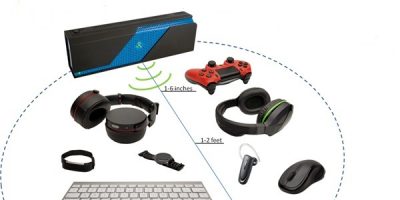PowerSpot transmitter is FCC-approved for power-over-distance wireless charging
At CES 2018, in Las Vegas (9 to 12 January 2018), Powercast will unveil its FCC-approved (Part 15, FCC ID: YESTX91503) and ISED-approved (Canada IC: 8985A-TX91503) three-watt PowerSpot transmitter.
The transmitter works at a field range of up to 80-ft (over 24m) for over-the-air charging of multiple devices. PowerSpot is, says the company, the industry’s first long-range, far-field, power-over-distance wireless recharging transmitter for consumer devices to gain FCC and ISED approval.
No charging mats or direct line of sight are needed. Powercast used the experience gained powering industrial and commercial devices with its initial Powercaster transmitter (FCC and ISED approved in 2010) to develop the new smaller, smarter and less expensive PowerSpot transmitter specifically for the consumer market.
Creating a coverage area like Wi-Fi, a Powercast transmitter automatically charges enabled devices when within range. The transmitter uses the 915-MHz ISM band to send RF energy to a tiny Powercast receiver chip embedded in a device, which converts it to direct current to power or recharge that device’s batteries.
Now that it is FCC-approved, Powercast will begin production of the standalone PowerSpot charger. It is also offering a PowerSpot sub-assembly that consumer goods manufacturers can integrate into their own products. Powercast predicts that lamps, appliances, set-top boxes, gaming systems, computer monitors, furniture or vehicle dashboards can become “PowerSpots” and able to charge multiple, enabled devices around them.
The company’s vision is to enable long-range, true wireless charging where consumers simply place all Powercast-enabled devices for charging within range of a PowerSpot in their home or a public place.
Powercast expects up to 30 devices left in the zone on a countertop or desktop overnight can charge by morning, sharing the transmitter’s 3.0W (EIRP) power output. Charging rates will vary with distance, type and power consumption of a device. Power-hungry, heavily used devices like game controllers, smart watches, fitness bands, hearing aids, ear buds, or headphones charge best up to two feet away (0.6m), for example, whereas keyboards and mice can charge at up to six feet (2.0m) away; TV remotes and smart cards up to 10-ft (3.0m) away; and low-power devices home automation sensors up to 80-ft (24.38m) away. An illuminated LED indicates devices are charging and it turns off when they’re done. Audible alerts indicate when devices move in and out of the charge zone.
The PowerSpot transmitter uses direct sequence spread spectrum (DSSS) modulation for power and amplitude shift keying (ASK) modulation for data, and includes an integrated 6dBi directional antenna with a 70-degree beam pattern.
At CES, Powercast will showcase a technology demonstration, developed with a partner, of a PowerSpot transmitter that adds the Qi inductive wireless charging standard adopted by many mobile phones. It combines RF over-the-air charging for multiple PowerSpot-enabled devices placed near the transmitter, and Qi proximity charging for power-hungry Qi-enabled mobile phones placed directly on the Qi charger on top of the PowerSpot transmitter.
Powercast is at booth 40268




